Coming up with small kids’ bedroom ideas is never easy, as you’re having to tick a lot of boxes at once. But it’s well worth giving it some careful thought before buying furniture or heading to the DIY store for tins of paint.
If you’re wondering how you’re going to get a tiny room to contain your child’s many belongings and ensure it’s a calm place for them to sleep, we have loads of children’s room ideas to get you started. As children grow, both boys’ bedroom ideas and girls’ bedroom ideas will need to triple up as a space for hanging out, doing homework and sleeping. So squeeze in more storage than you think you could possibly need and seek out colours, patterns and designs that will be able to grow with them.
Small kids’ bedroom ideas
‘Go for multi-purpose storage that can be adapted for their needs such as under the bed for toys and clothes, or storage under a desk for colouring pencils and books,’ suggests Ann Marie Cousins, Founder of AMC Design (opens in new tab). ’Storage boxes and accessories can also be changed as a child’s taste changes as they grow up, so keep the core of the room (and the big ticket items) neutral so they don’t need to be replaced.’
1. Conceal clutter with a curtain
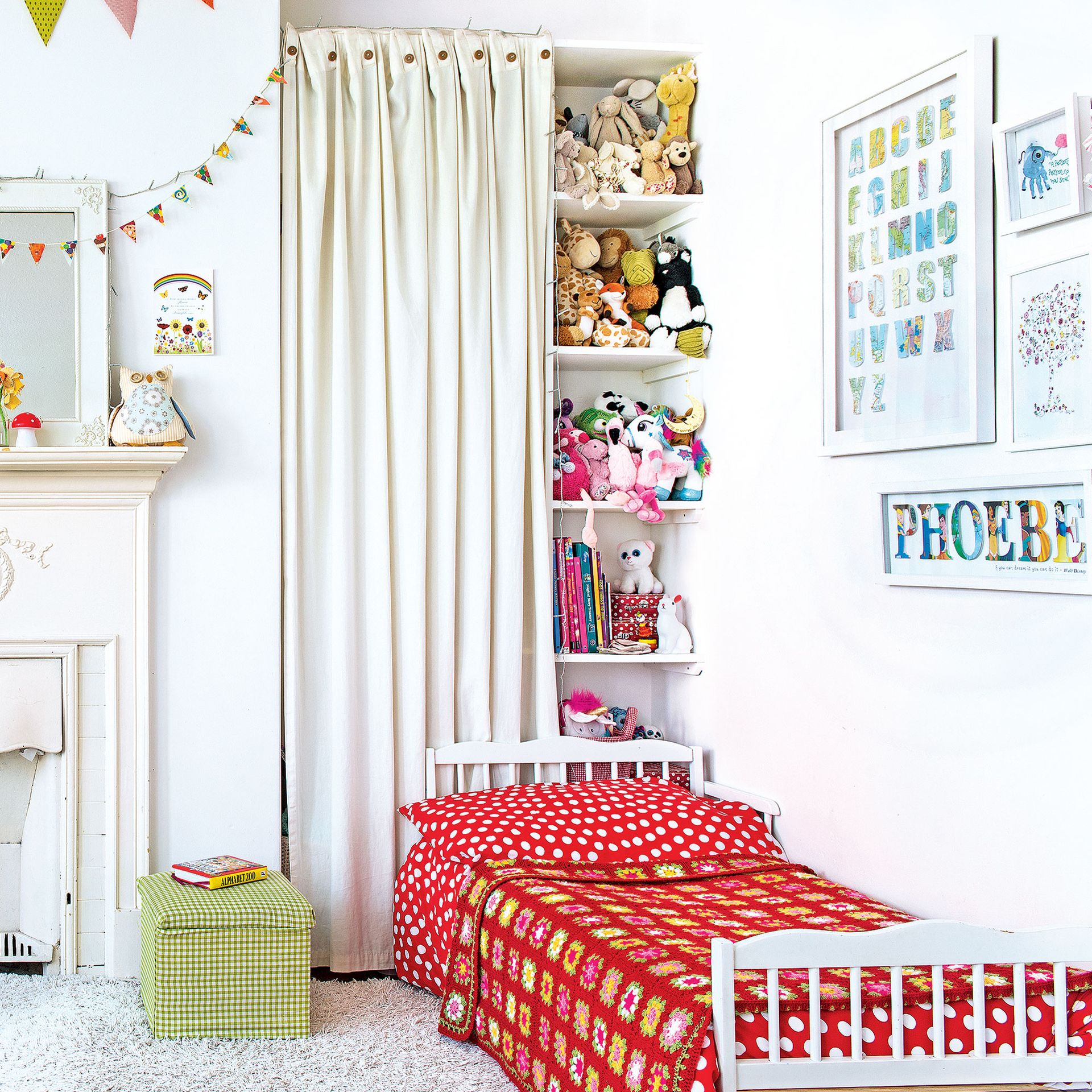
(Image credit: Future PLC / Colin Poole)
‘Not only are bedrooms a space for sleep and relaxation, but they are also a place for kids to play and be creative, so they often have lots of toys and games,’ comments Ann Marie Cousins. ‘Storage plays a key role in a child’s bedroom, so ensure that functional storage is smartly incorporated into the space, without it feeling overcrowded.’
One way to make your small kids’ room transition more easily from playtime to bedtime is by having a curtain that can be drawn over shelves of toys and books. This toy storage idea means kids can proudly display their favourite toys and have them within reach for playing, but when it’s time to settle down for bed, the room won’t feel cluttered or overstimulating. While they might be very busy during the day, kids need a calm environment to get a good night’s sleep just like we do.
2. Throw down a colourful rug
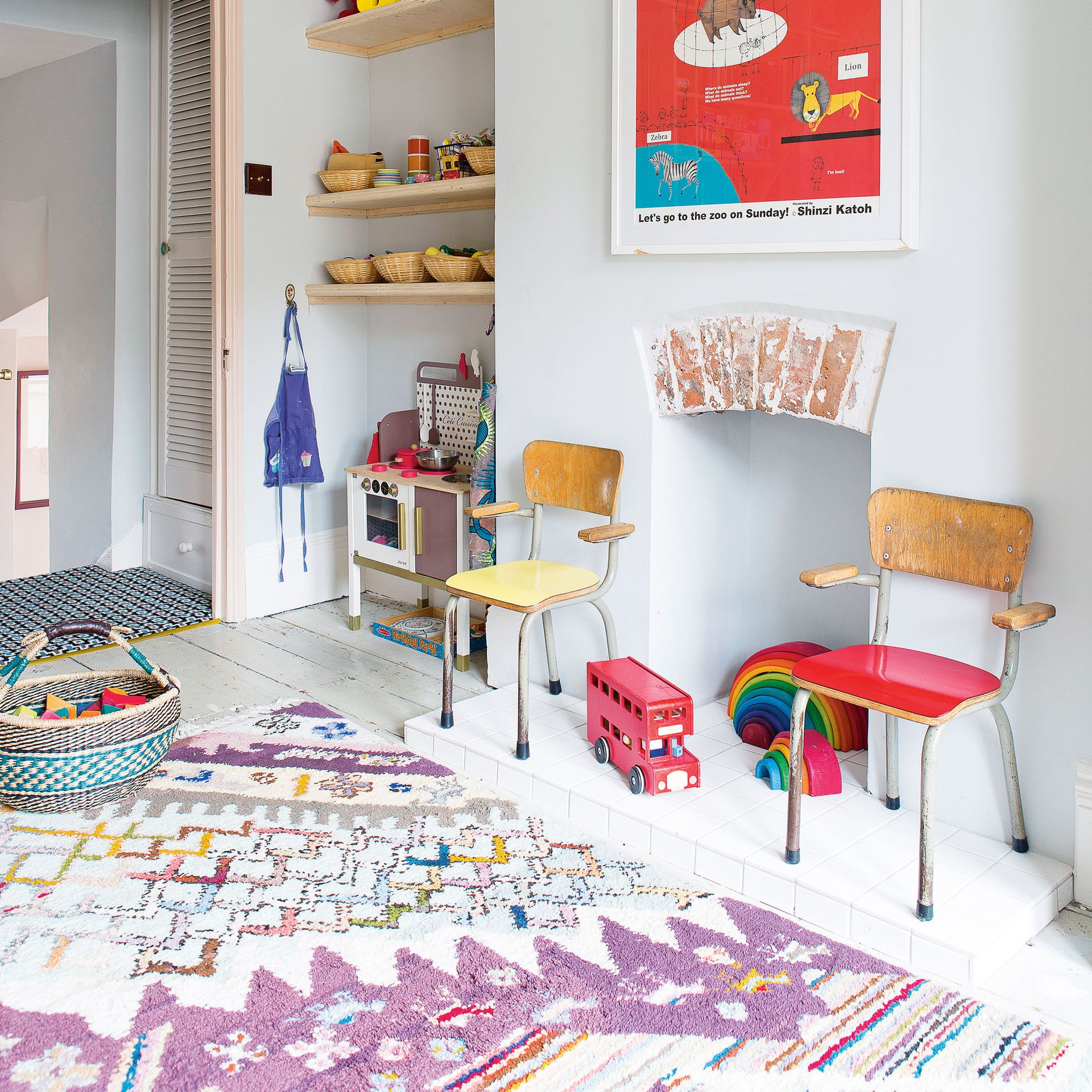
(Image credit: Future PLC / Jo Bridges)
A big rug is a no-brainer in a small kids’ room. It’ll anchor the space, add soft texture for tiny toes and, if you go for something patterned, it’ll be forgiving of felt-tip pen marks and any other stains (although watch out for the LEGO/race cars underfoot). The best rugs can instantly make any room feel more welcoming and give a bit of cushioning on knees and elbows for kids playing on the floor. Rugs also have the added bonus of softening the acoustics so not every single thud of an indoor football can be heard downstairs.
3. Build a space-savvy window seat
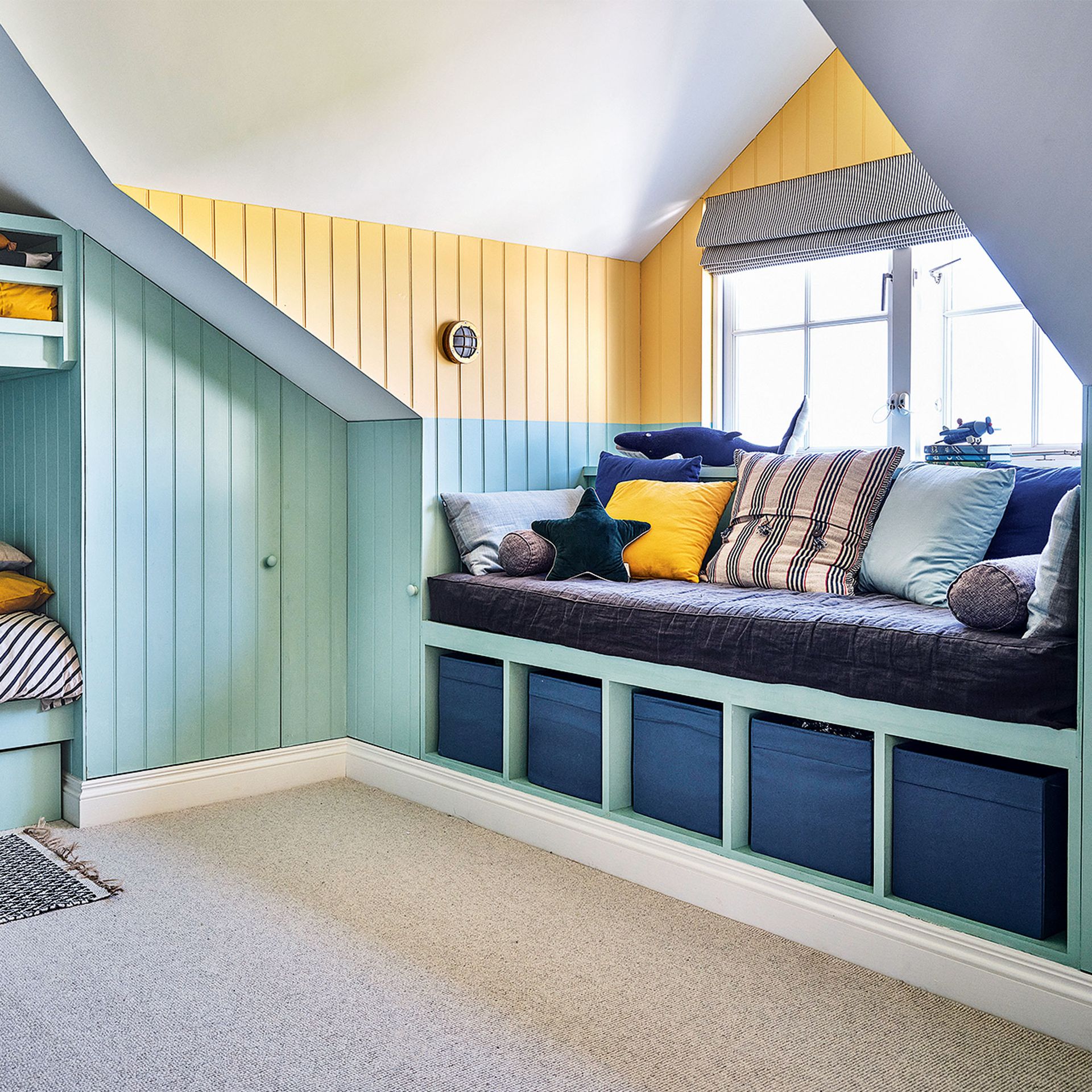
(Image credit: Future PLC / Dan Duchars)
Incorporate a compact window seat to create a cosy area for reading and chilling out that won’t encroach too much on the rest of the room. Add storage boxes beneath so your little one has lots of space to put their toys and games, and layer up with lots of cushions. Interior design expert Ann Marie Cousins says you can have fun with storage boxes and bins by using different colours for different items. ‘This will also help encourage your children to store their items correctly, as I find they react really well to colour,’ she says.
4. Create a magnetic feature wall
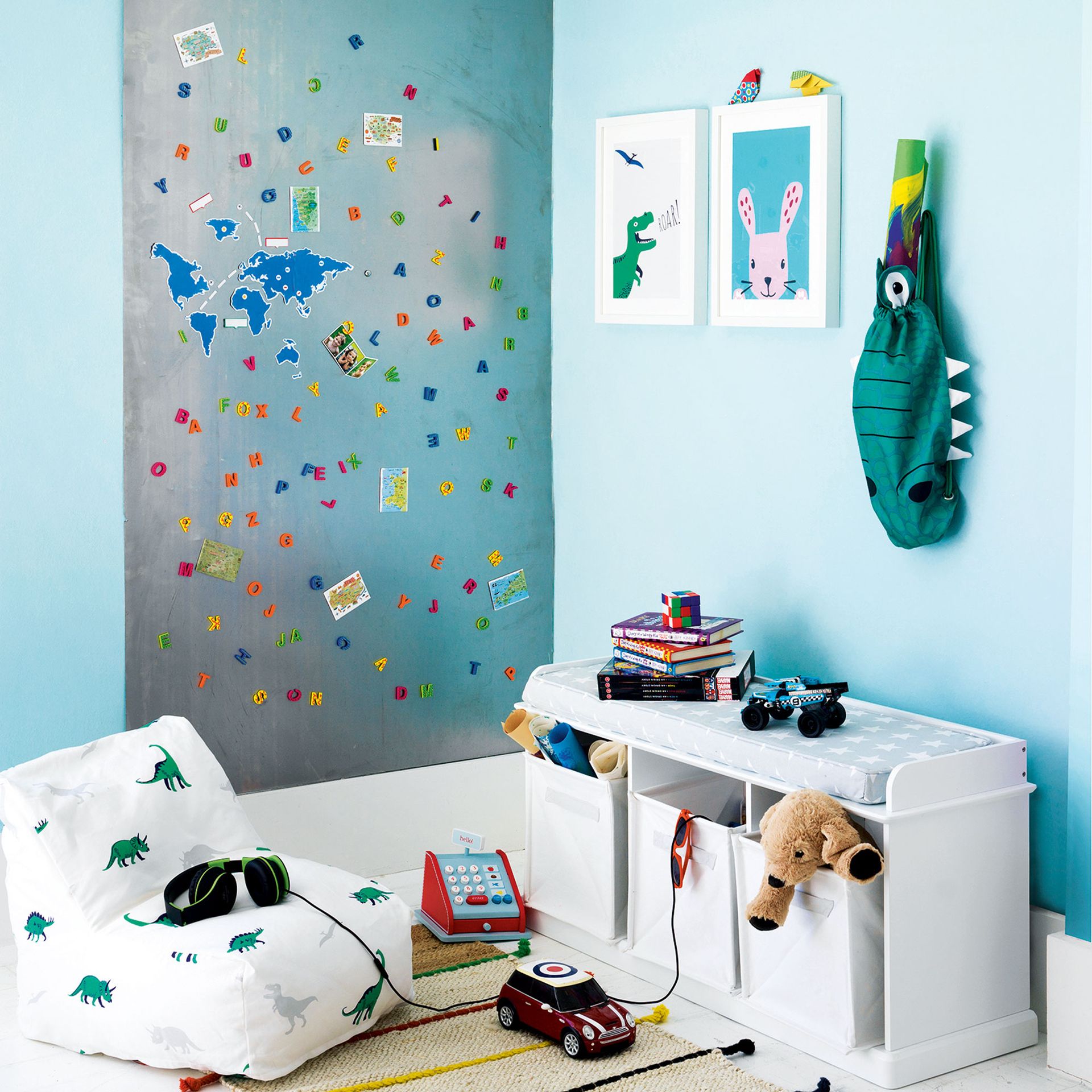
(Image credit: Future PLC / Simon Whitmore)
Why not make a fun magnetic wall in your small kids’ bedroom? This might help you carve out a mini ‘play zone’ with other toys and some comfy seating. You could make yours with magnetic paint or install a magnetic memo board available at places like IKEA. A magnet wall provides a lovely place to show off paintings, or for playing with solar system magnets, animal magnets, or spelling out their name with classic letters of the alphabet.
‘Kids are forever growing, and their bedrooms need to evolve with them – creating different pockets of space helps with this and zones the room for learning, playing and relaxing,’ comments Rona Olds, Director of Product at Habitat (opens in new tab). As they get older, the magnet wall can become a place for pinning useful reminders and revision cards.
5. Distract with an accent colour
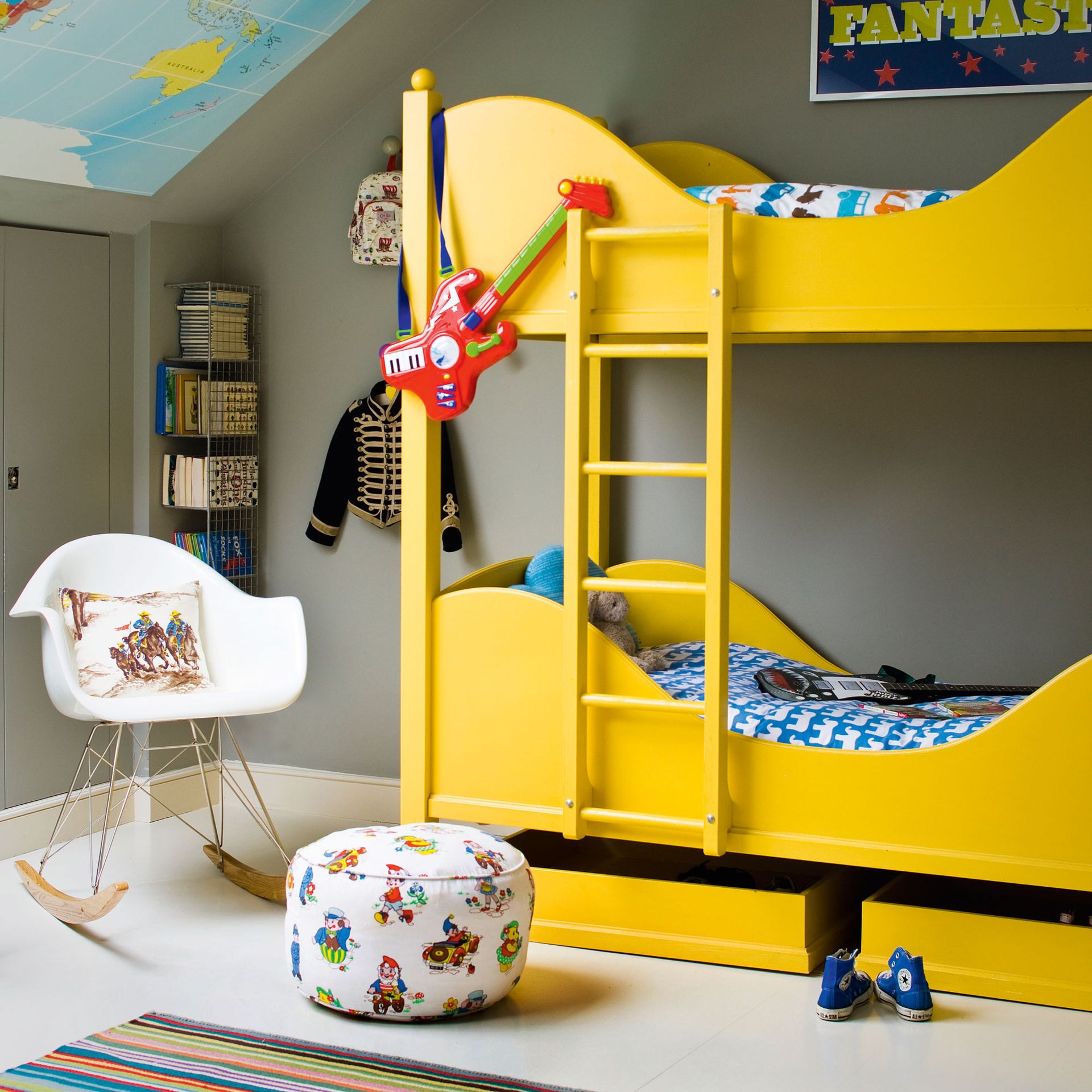
(Image credit: Future PLC / Jeroen van der spek)
Upcycle existing furniture with a bright paint shade of your child’s choice. Going for something bold on bedframes, wardrobes and chests of drawers will create a big impact and draw attention away from the room’s petite proportions. Here, yellow and grey complement each other in a stylish and functional kids’ room. The curved wooden shapes of the bunk bed design score extra design points.
6. Make a reading corner with floor cushions
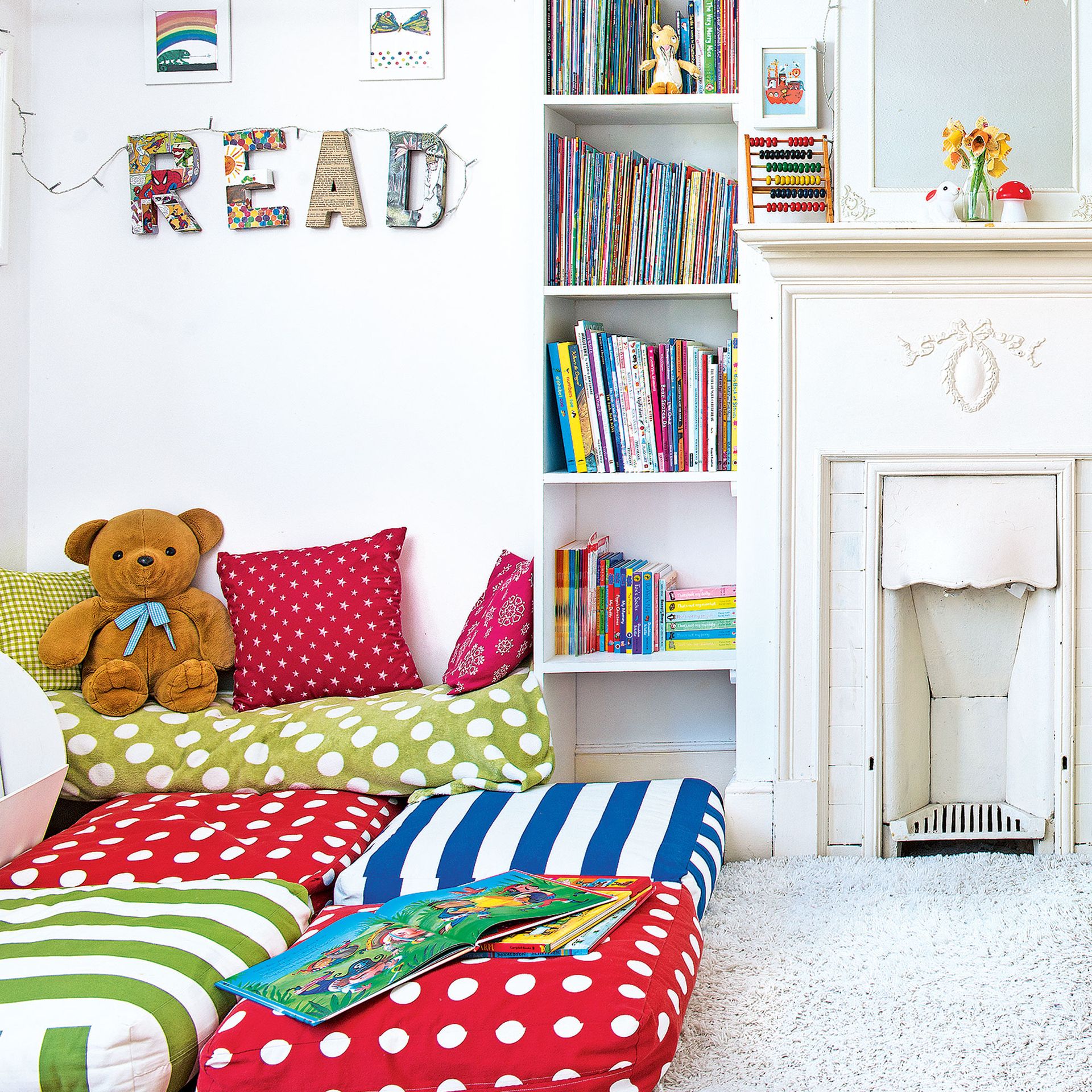
(Image credit: Future PLC / Colin Poole)
Lay down floor cushions near your child’s bookshelves, hang artwork related to their favourite stories and put up fairy lights to make a cosy atmosphere perfect for reading stories together. Stack floor cushions up and store them on top of wardrobes when not in use to give you more space for playing games.
7. Keep tiny furniture as long as possible
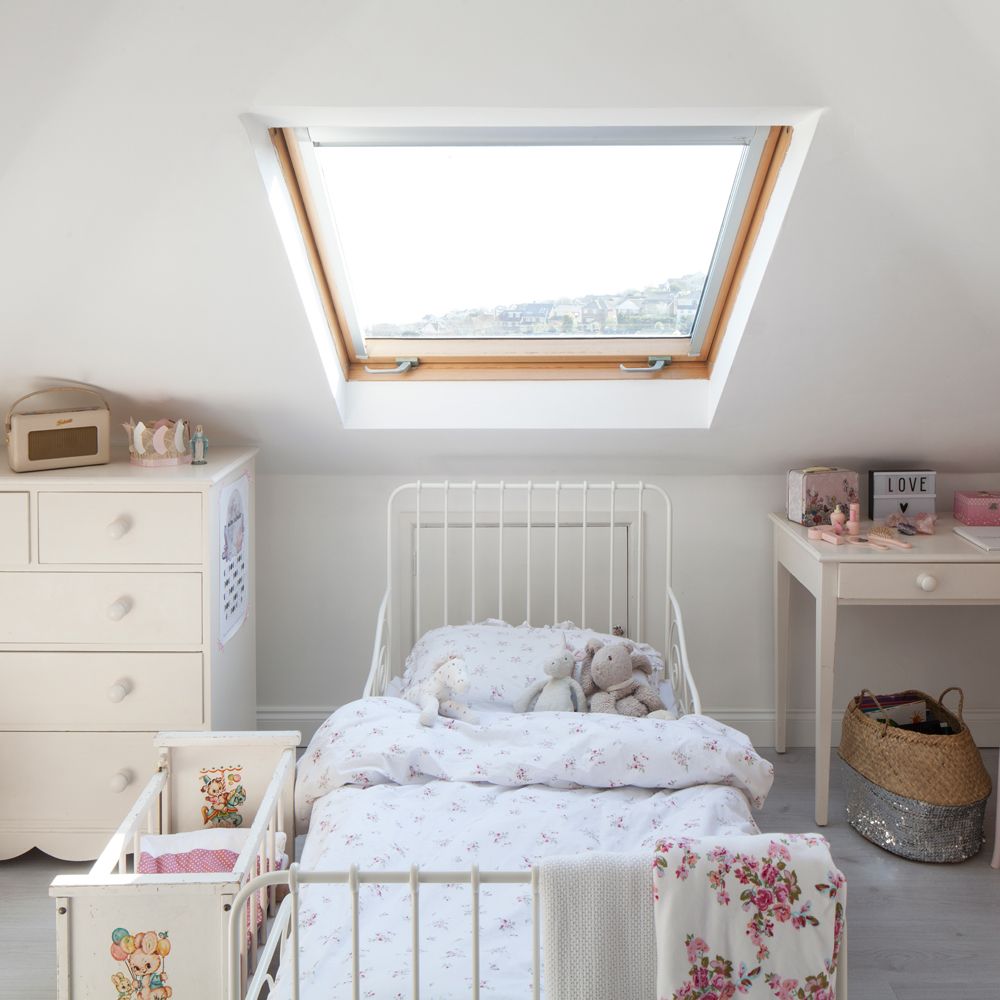
(Image credit: Future PLC/ James French)
Don’t upgrade your child’s toddler bed until the last minute. Most cots convert into toddler beds and you’ll be amazed at the difference in size they are compared to a standard single. Depending on individual size and growth, your child shouldn’t need a full-size bed until they are around primary school starting age. The same goes for wardrobes and chests of drawers; tiny clothes take up less room, so stick to small proportioned furniture for as long as possible to leave more floor space for play.
8. Make sure everything is easily accessible
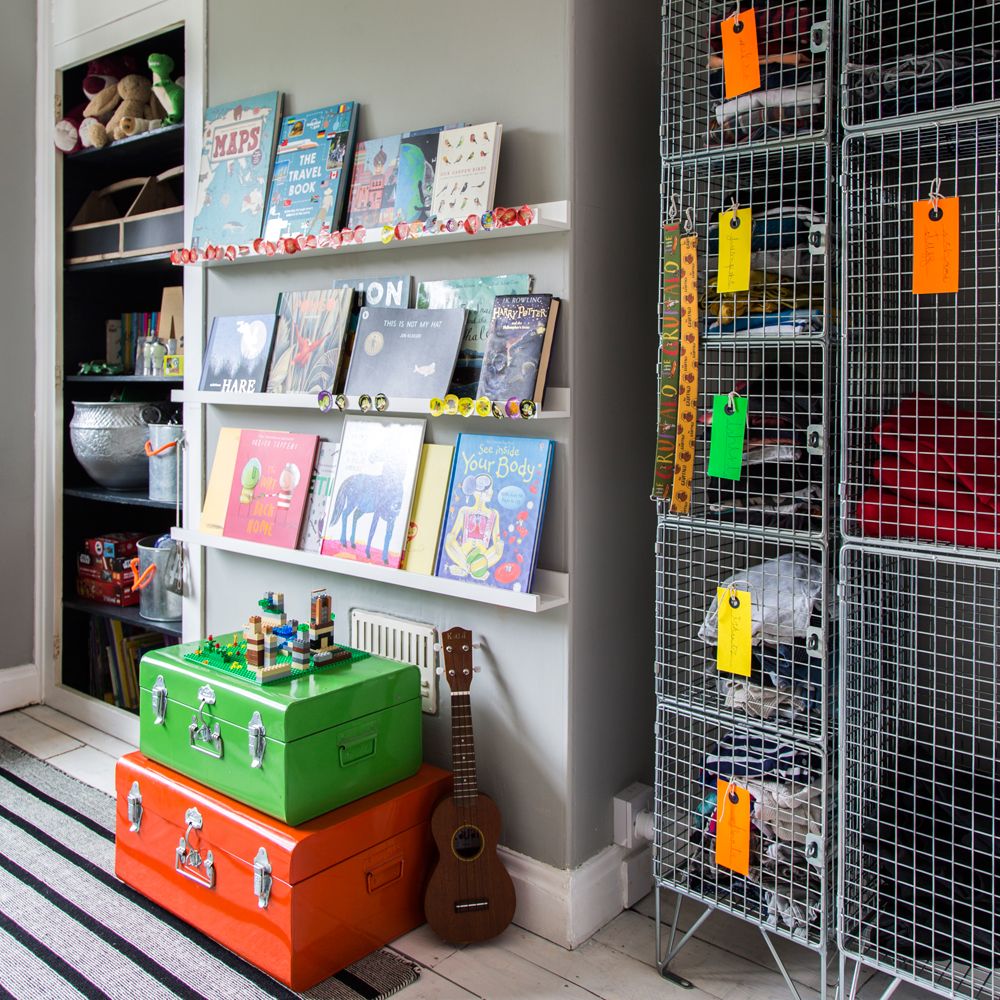
(Image credit: Future PLC/ Lizzie Orme)
Owning a small children’s bedroom doesn’t mean a child will accumulate fewer belongings. In fact, younger children’s toys are notoriously larger than big kid versions, so it’s time to get savvy with storage. Encourage tidiness in a small space by ensuring storage is easily accessible and within reach for little ones. Create a library for oversized books displayed front ways. Remove fitted wardrobe doors for an uncluttered and airy look and replace them with shelves for baskets and bins. Labelled wire storage will keep clothes off the floor.
9. Store toys under the bed
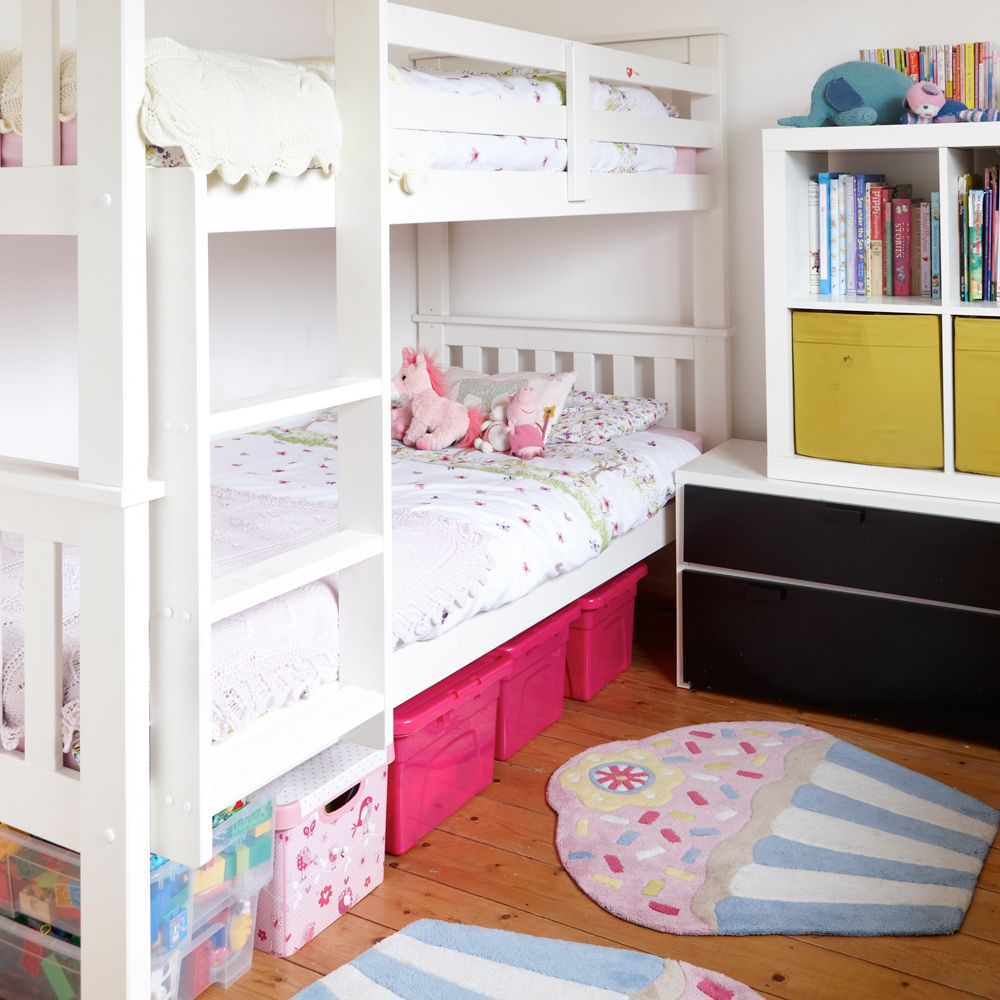
(Image credit: Future PLC/ Keith Henderson & David Hampton)
Under-bed storage is a godsend in children’s bedrooms as toys can be organised and out of sight and the low level means little ones can access what that need (and hopefully tidy away too). For a streamlined look chose a bed that comes with a matching under-bed trundle on wheels. Or for a budget version, make it colourful and fun with a series of bright plastic boxes. Your little one will enjoy making labels for boxes too.
10. Invest in a toy chest
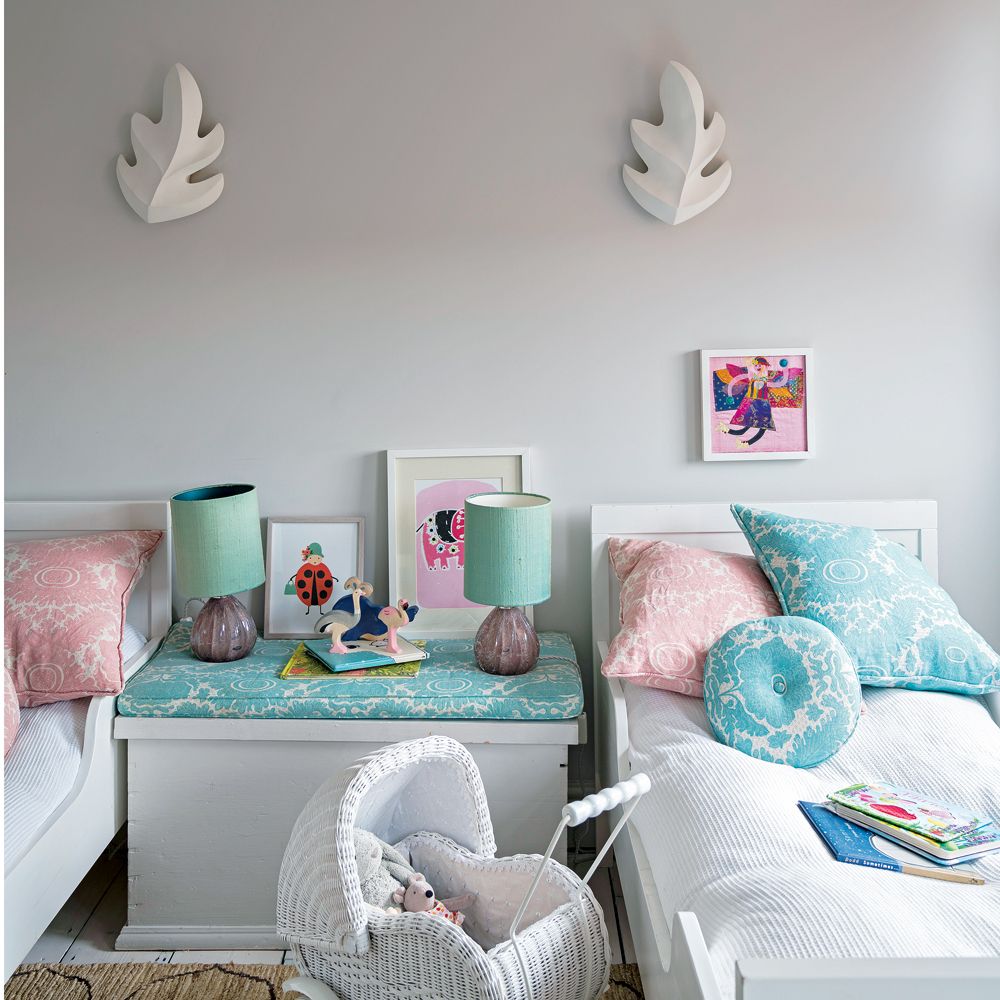
(Image credit: Future PLC/ James Merrell)
There’s a reason sturdy wooden toy chests have been around for centuries – they are super useful! And, if you can make yours multi-functional, even better. This wooden ottoman works as storage, a colour co-ordinating bench with a soft seat pad and triples as a nightstand in this twin children’s bedroom. Make it practical by storing items that may not be used every day, such as fresh linens, warm blankets or out of season clothing.
11. Pop a pull out desk under a raised bed
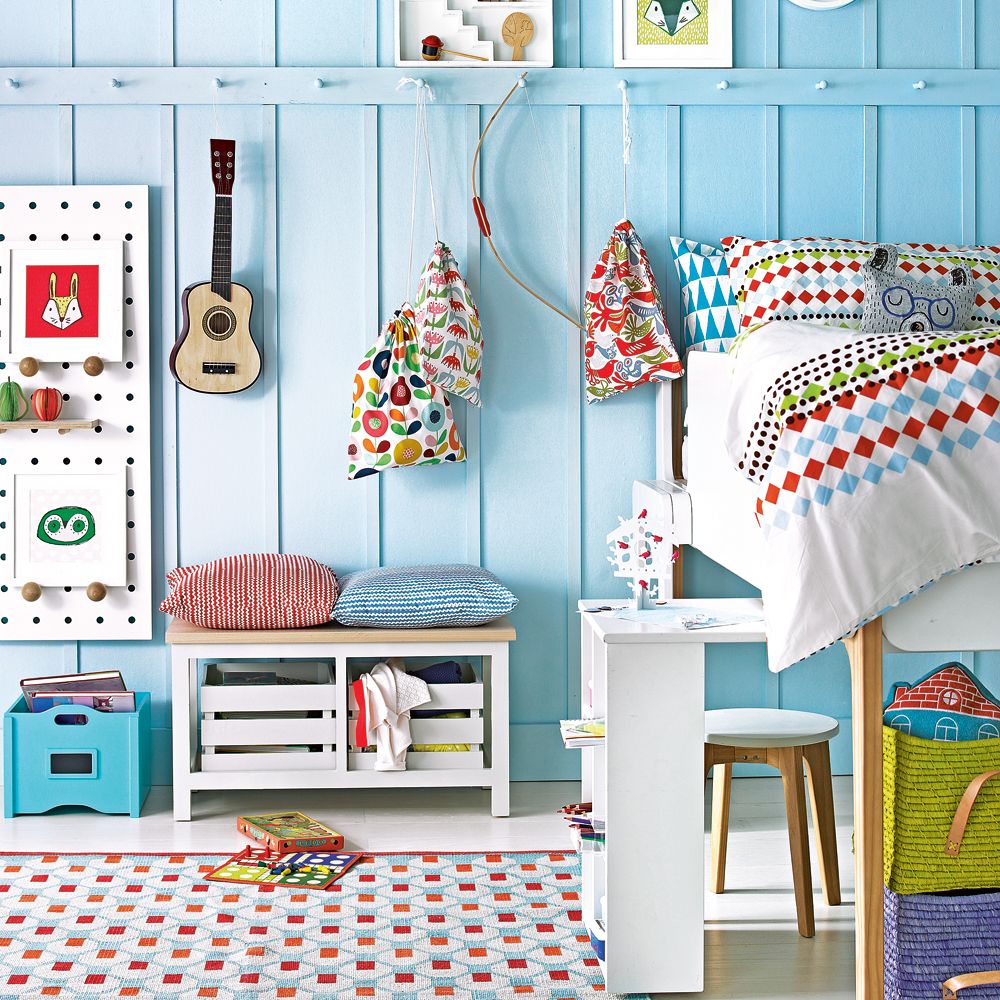
(Image credit: Future PLC/ David Brittain)
When space is a premium, squeezing a desk into a children’s bedroom can be impractical. Instead, go for a cabin bed or mid-sleeper that comes with a pop-out desk and can be used as and when it’s needed only. They often come with additional side storage too. Alternatively, a pull-down table fixed to a wall or floating shelf mounted at waist level is a space-saving option as vital desk space.
12. Create more floor space with a high sleeper
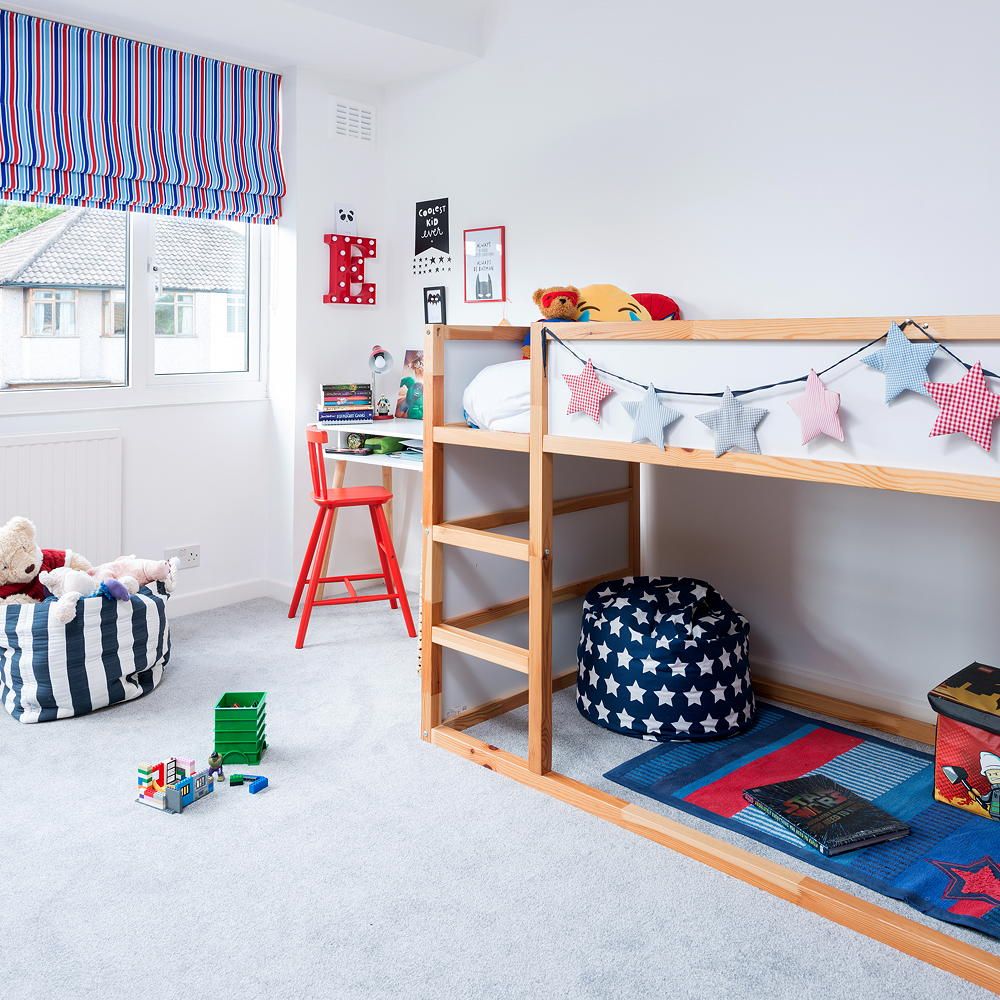
(Image credit: Future PLC/ Jeremy Lawrence)
Floor space is precious in a kids’ room, it’s the building zone for lego, trains, fairy kingdoms and hours of fun. So a high sleeper is a great option. Alex & Kris, Founders & Directors, Nöa & Nani (opens in new tab) point out that the space beneath can easily be changed into a functional desk area for learning when children are older. ‘We also suggest adding some high shelving so that books can be easily reached for bedtime stories,’ they advise.
In this room, the space under the bed has been turned into a lounging den for reading. As your child grows up this space can be adjusted to provide extra room to store for clothes or a desk.
13. Utilise wasted wall space for storage
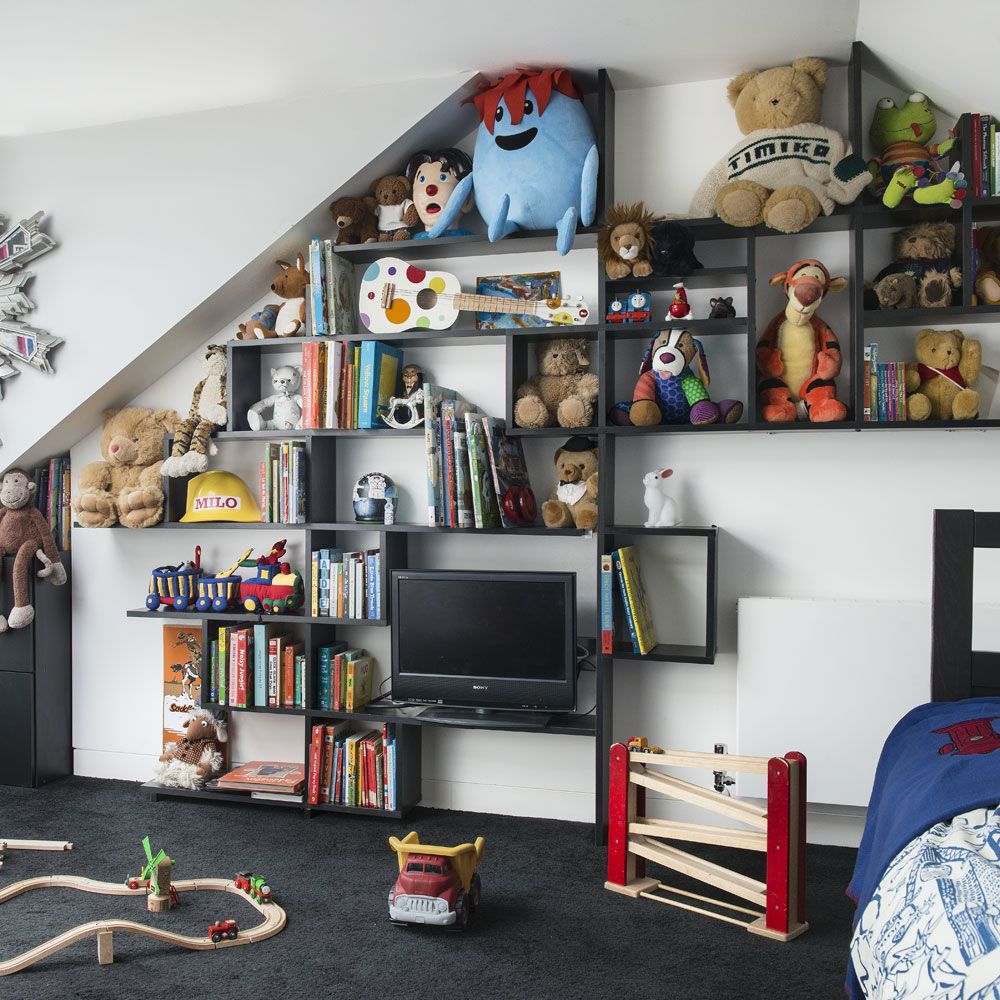
(Image credit: Future PLC/Colin Poole)
For the ultimate children’s room storage idea go bespoke for wall storage. This smart kid’s room features a wall of storage cubes to elevate everything off the floor and onto one wall – including everything from the TV to books and cuddly toys. This solution is ideal for small spaces because you have the vertical advantage of using wall space you wouldn’t otherwise be using.
Whether a full wall or just a small section of a free wall allows plenty of storage potential, from floor to ceiling being utilised. Freeing up the floor space not only makes the rooms feel bigger, but also creates valuable space for little ones to play.
14. Be clever with built in storage
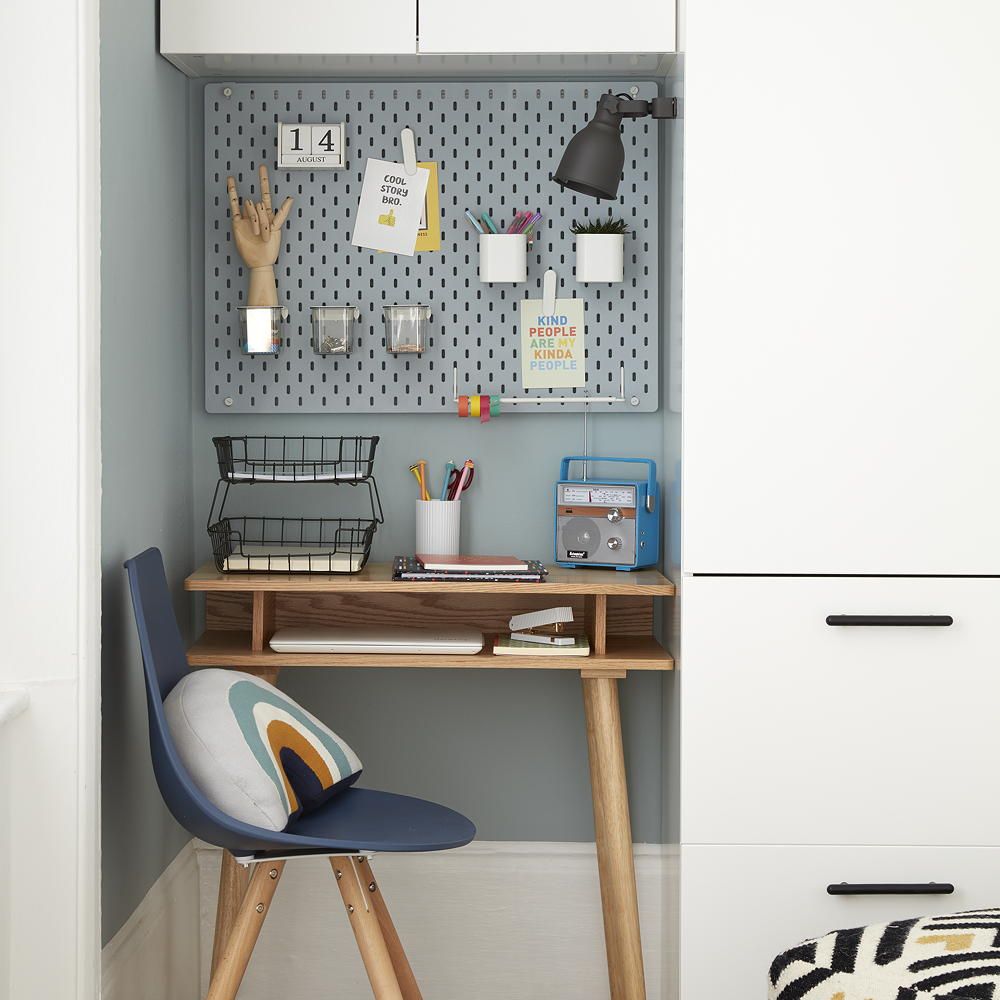
(Image credit: Future PLC)
In a small room built-in storage can be a lifesaver in making sure the room feels spacious for your child, but still fits all their belongings in. When fitting a built-in wardrobe along one wall, leave a small cut-out for a slim laptop desk, future-proofing the room ready for more grown-up teenage bedroom ideas.
A pinboard like the one in this room can be added above the desk to attach pencil pots, lamps and even a tiny house plant. This will help leave the desk clear so there is plenty of space for them to do their homework.
15. Put a peg rail above the bed
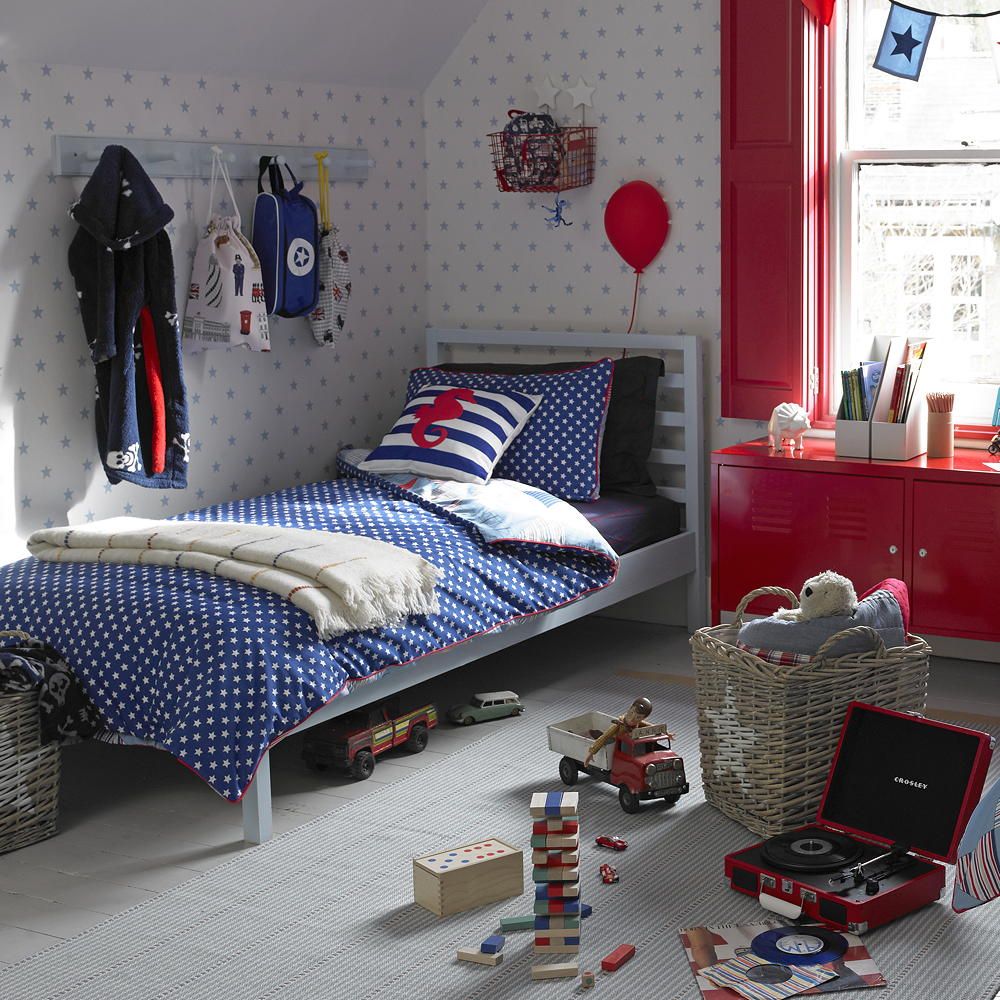
(Image credit: Future PLC/ David Brittain)
The space over the bed is often only used for wall art and stickers, but double this up as extra storage by placing a peg rail over it. Your child will be able to grab their dressing gown as soon as they step out of bed, and they’ll never be able to complain about losing their PE bag again. From a safety point of view ensure you only hang items that won’t fall off and cause any harm to a sleeping child beneath.
16. Paint floorboards a similar colour to the walls
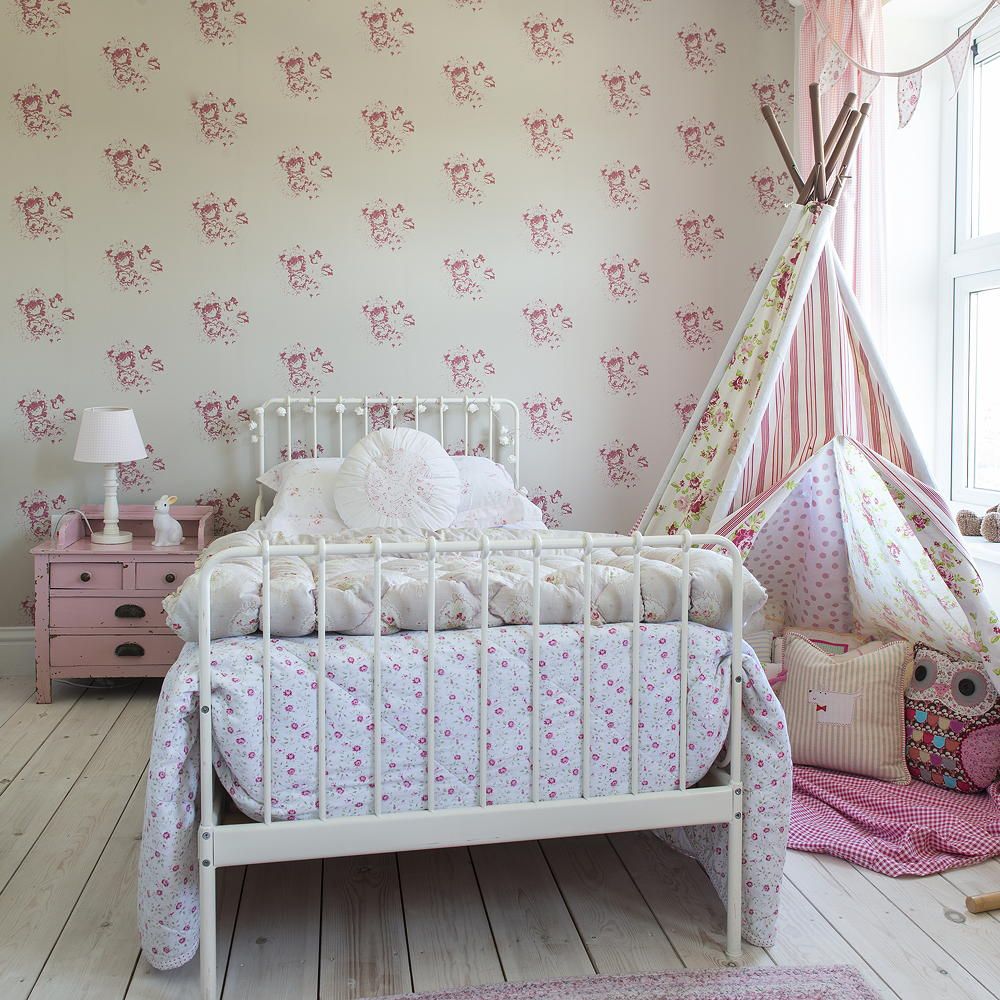
(Image credit: Future PLC/ Colin Poole)
From looking at this room you would never be able to guess the size of it. Despite the tent that has be squeezed into the corner this room looks far from cluttered. This is thanks to the light colour scheme which has been extended from the walls to the floorboards. Carpets might feel a more natural choice in a kids room, but the bare floorboards make the space feel more spacious than it is, you also have the option to play around with rugs for added warmth and comfort.
17. Swap bookshelves for floating shelves
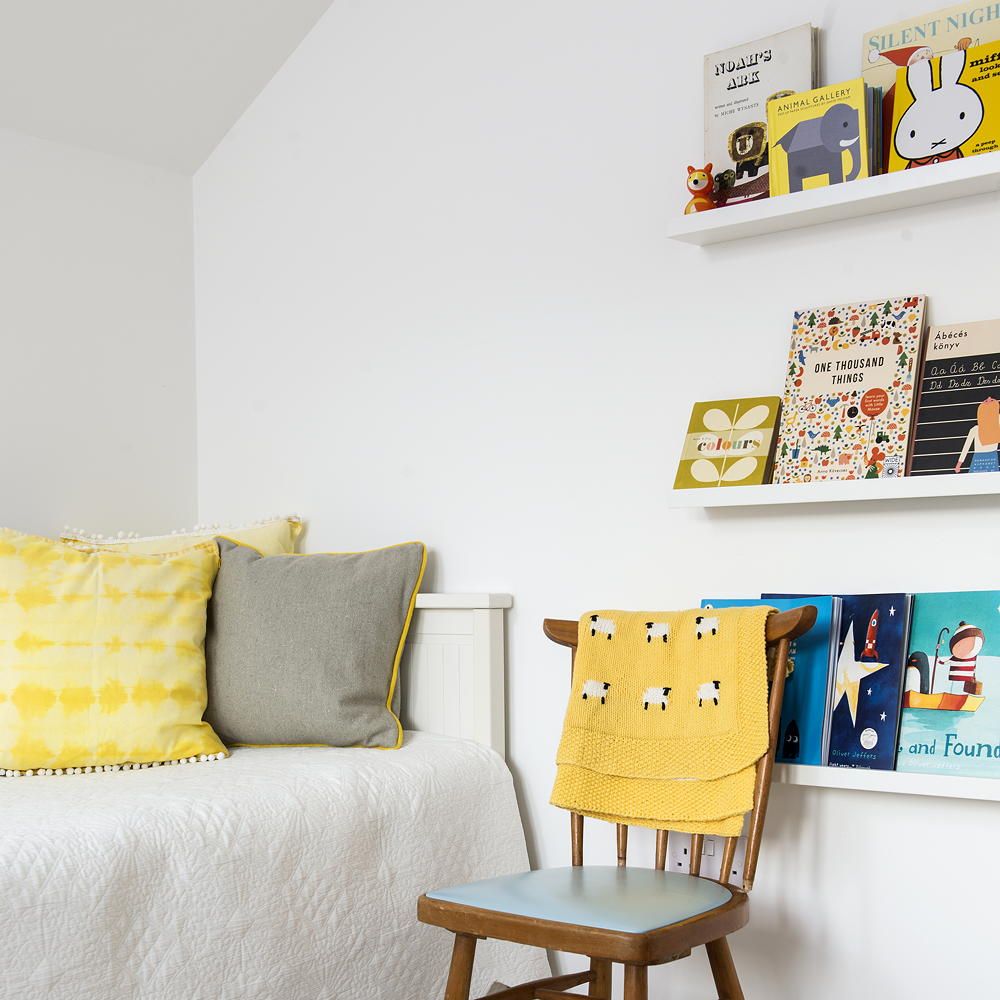
(Image credit: Future PLC/ Colin Poole)
If you’re child is a keen reader, but their small room means there isn’t enough space for a proper book shelf, try installing some floating shelves. They might not be able to hold up the last few Harry Potter books, but anything less than 300 pages should be fine. It is also a great way to create a feature wall in a small space that is functional and stylish.
18. Keep the colour scheme balanced
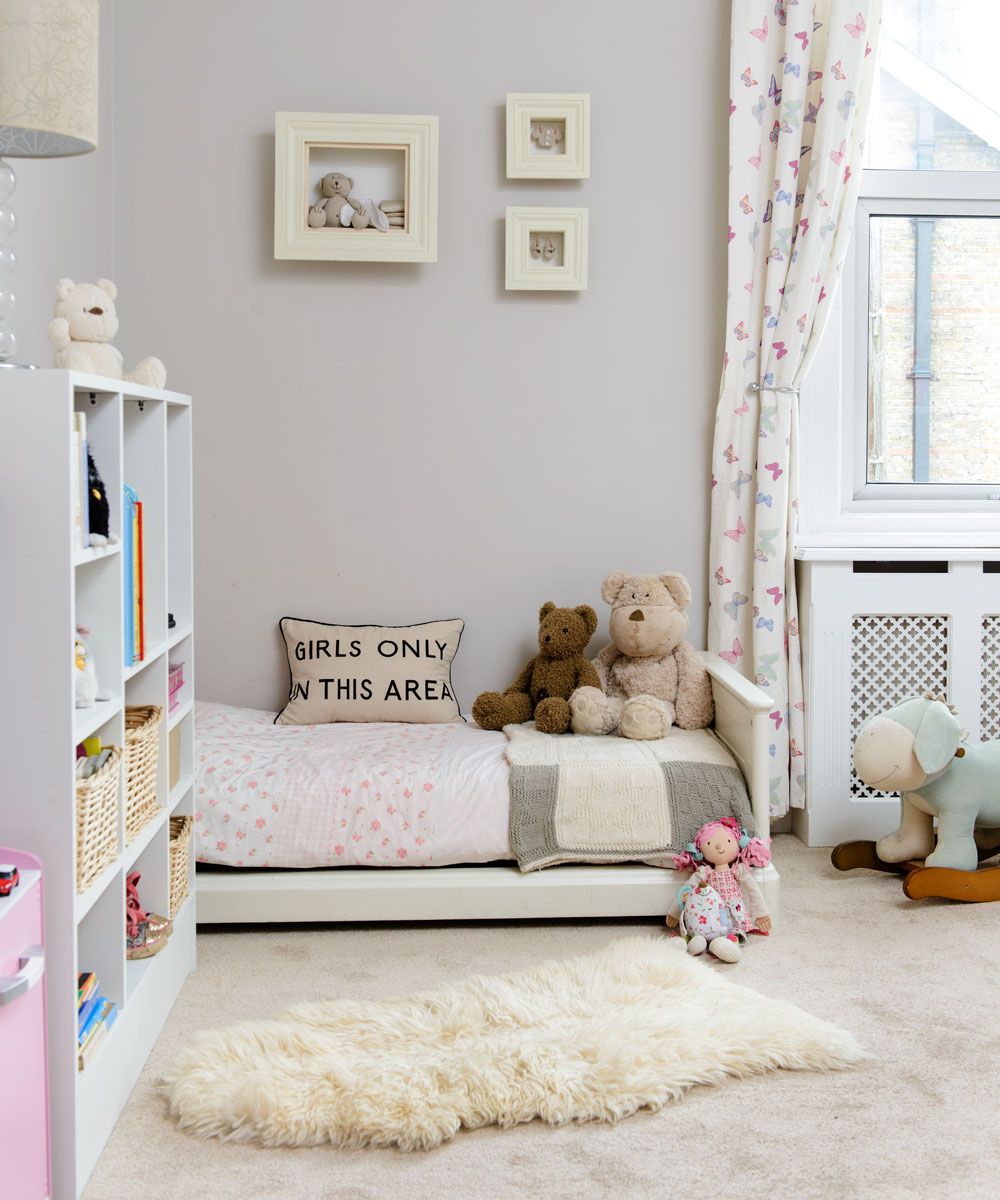
(Image credit: Future PLC/ Colin Poole)
Small rooms can become easily overwhelmed by clutter and busy colour, leaving them feeling cramped. For this reason, it pays to keep a compact space white, but this doesn’t mean colour and pattern can’t be used to add fun and character. Window treatment ideas and bedding are the perfect vehicles for colourful scenes and patterns, and will bring the bed and blinds or curtains into sharp relief in a white room.
Add scatter cushions and rugs to increase the impact. Alternatively, knock colour back to a few key accessories, such as table lamps or wall art for a more controlled scheme. Bear in mind that objects and toys targeted at children are often brightly coloured or patterned, so that once the room is a little more lived-in it may appear more balanced than when first painted.
19. Add smart storage solutions
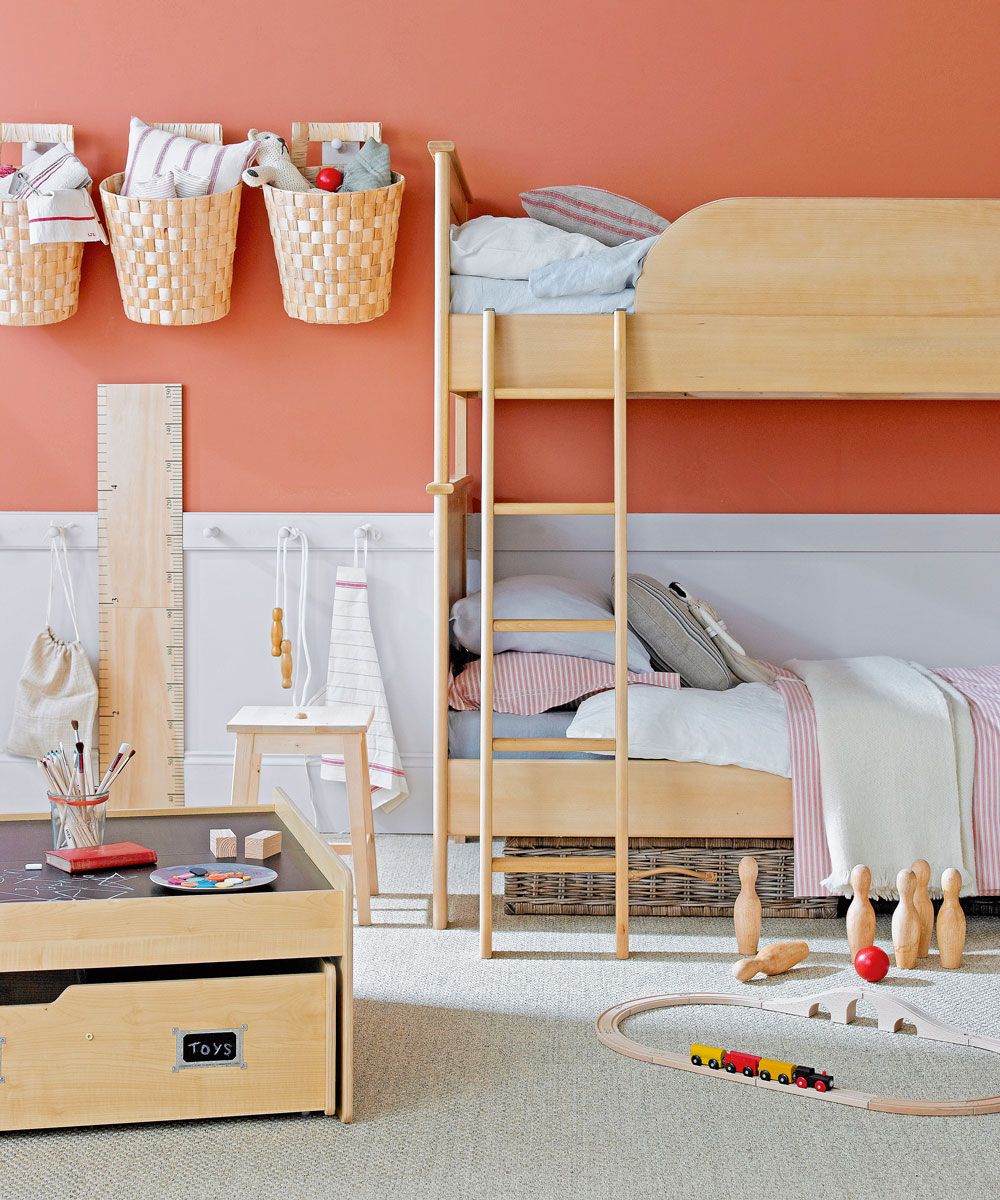
(Image credit: Future PLC/ David Brittain)
When it comes to storage for a small kid’s bedroom you need to think outside the box. Quite literally, by limiting the amount of bulky storage, such as wardrobes and chests of drawers. Instead think about adding peg rails, clothes rails and baskets all attached to the walls to minimise impact on the room but maximise storage potential.
20. Buy the right bed
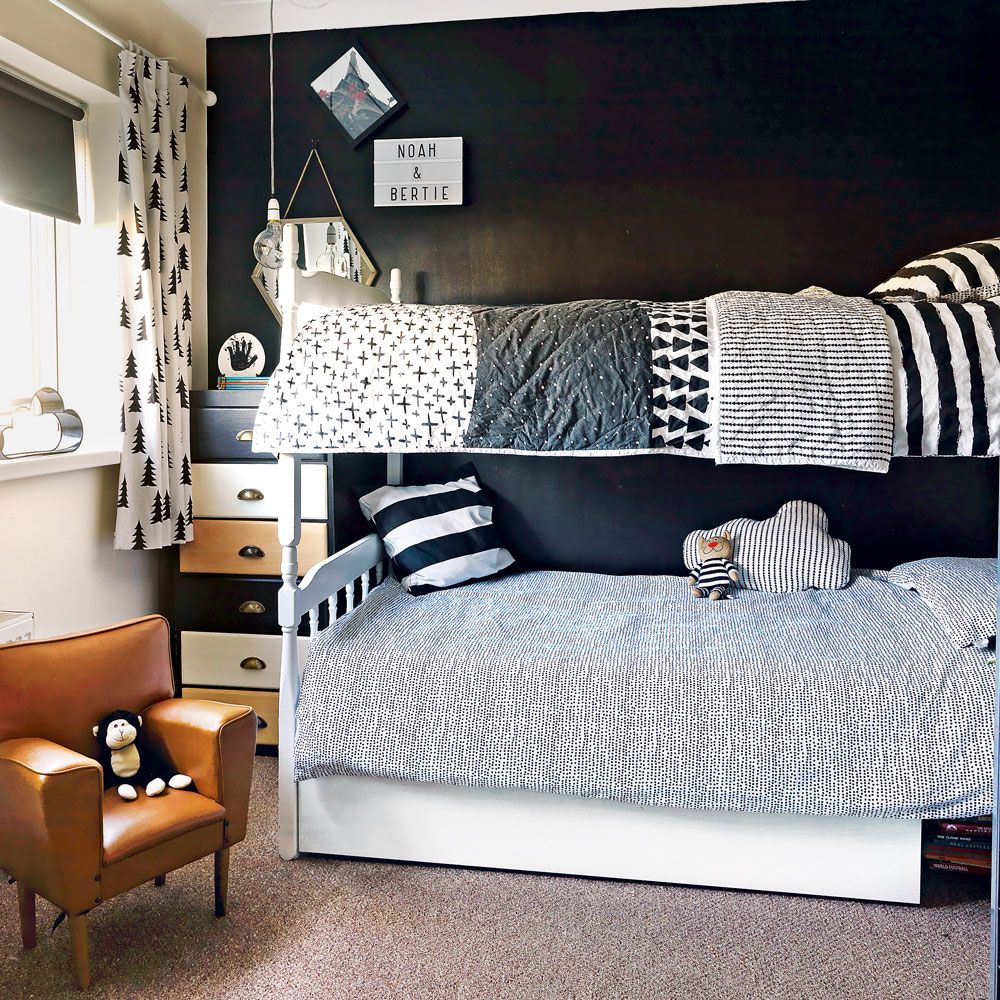
(Image credit: Future PLC/ Simon Whitmore)
Often the focal point of the room, the bed is a crucial consideration. Traditional bunk-beds are the perfect space-saver if you have a small room shared permanently by two children. It is also worth considering buying children’s rather than adult-size furniture, as one way of increasing floor space.
Most bunk bed designs, for example, can be bought in narrower and shorter sizes. However, you will need to weigh this up against the added expense of having to buy again once your child outgrows everything.
21. Limit wallpaper to one wall
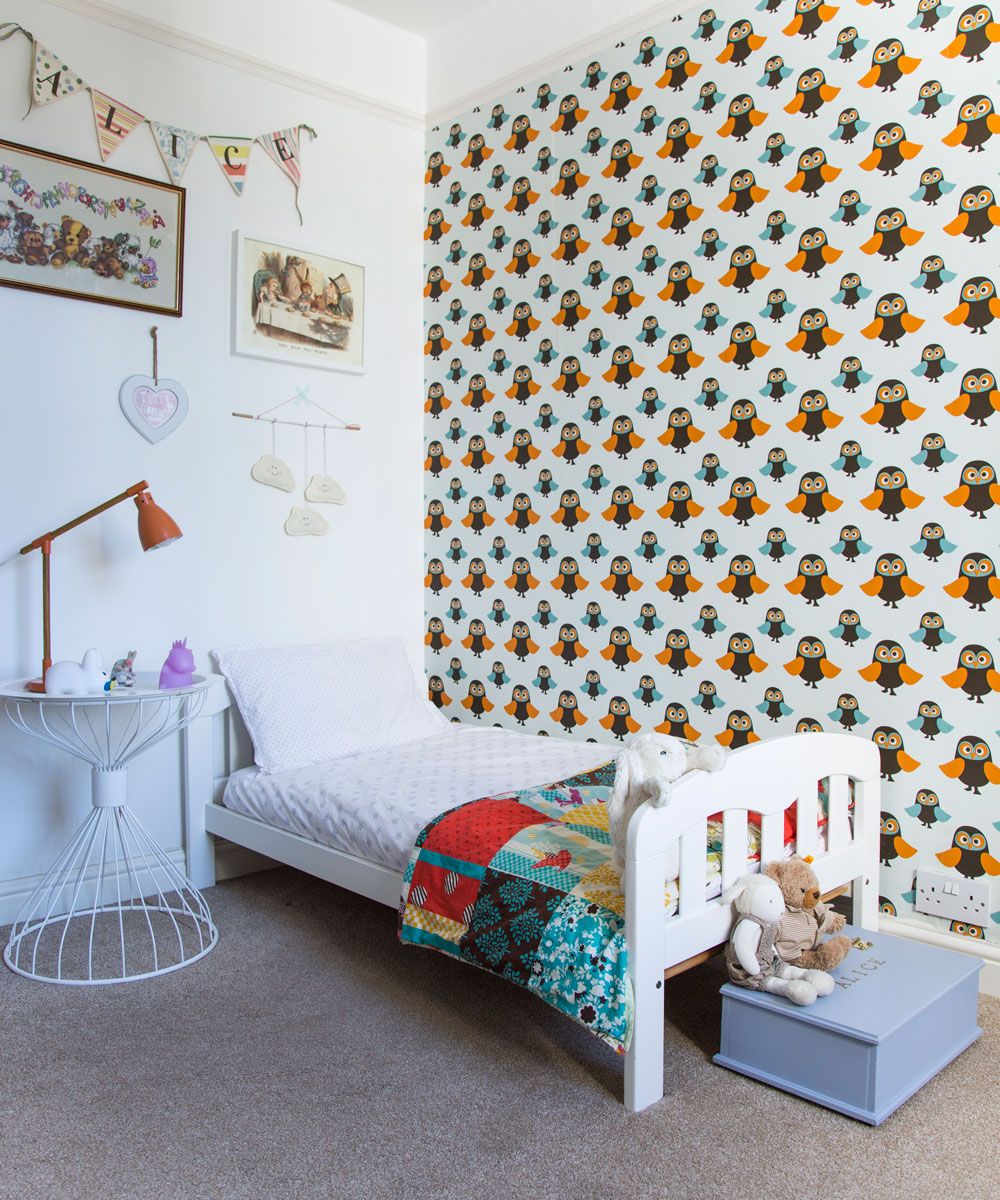
(Image credit: Furniture PLC/ Lizzie Orme)
With so many adorable options out there for children’s wallpaper, it’s easy to fall in love with some bright, bold pattern. Don’t despair: although simpler is generally better with small spaces, it can be done. If you keep the print to one wall and ground it with furniture in front, you can achieve both cute and charming.
Keep the rest of the room relatively simple in contrast, but with some smaller spots of vibrancy to keep the scheme balanced, ideally picking out and continuing a colour. Here, the orange bedside lamp calls back to the orange wings of the owls, and the patchwork quilt has detailing which harks back to the blue.
22. Assess the shape of the room
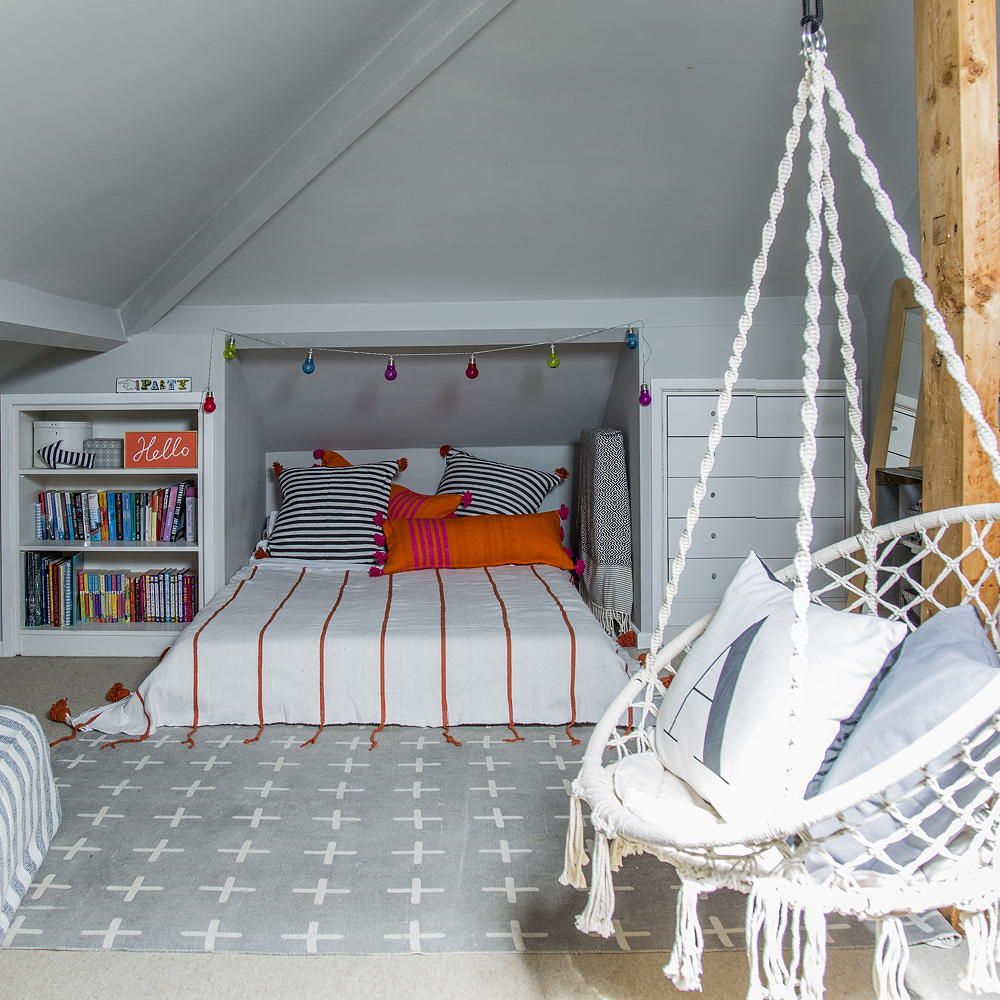
(Image credit: Future PLC/ Lizzie Orme)
Awkwardly shaped rooms can be tricky to decorate. Make use of alcoves by building in storage like the shelves and drawers in this room – think about going bespoke if you are struggling to find something that fits. Instead of a bed frame opt for a futon or low platform bed that can be slotted under a lower ceiling.
If your room is in the eaves, squeeze a few bean bags into the corners to make a cosy lounging area. Any beams can also be used to attach rails or pegs for clothes, instead of trying to wrestle a wardrobe into the room. Make a splash in the room by fitting a hanging chair to the highest ceiling point in the centre of the room, just make sure you hang it from a sturdy beam.
23. Invest in multi-functional furniture
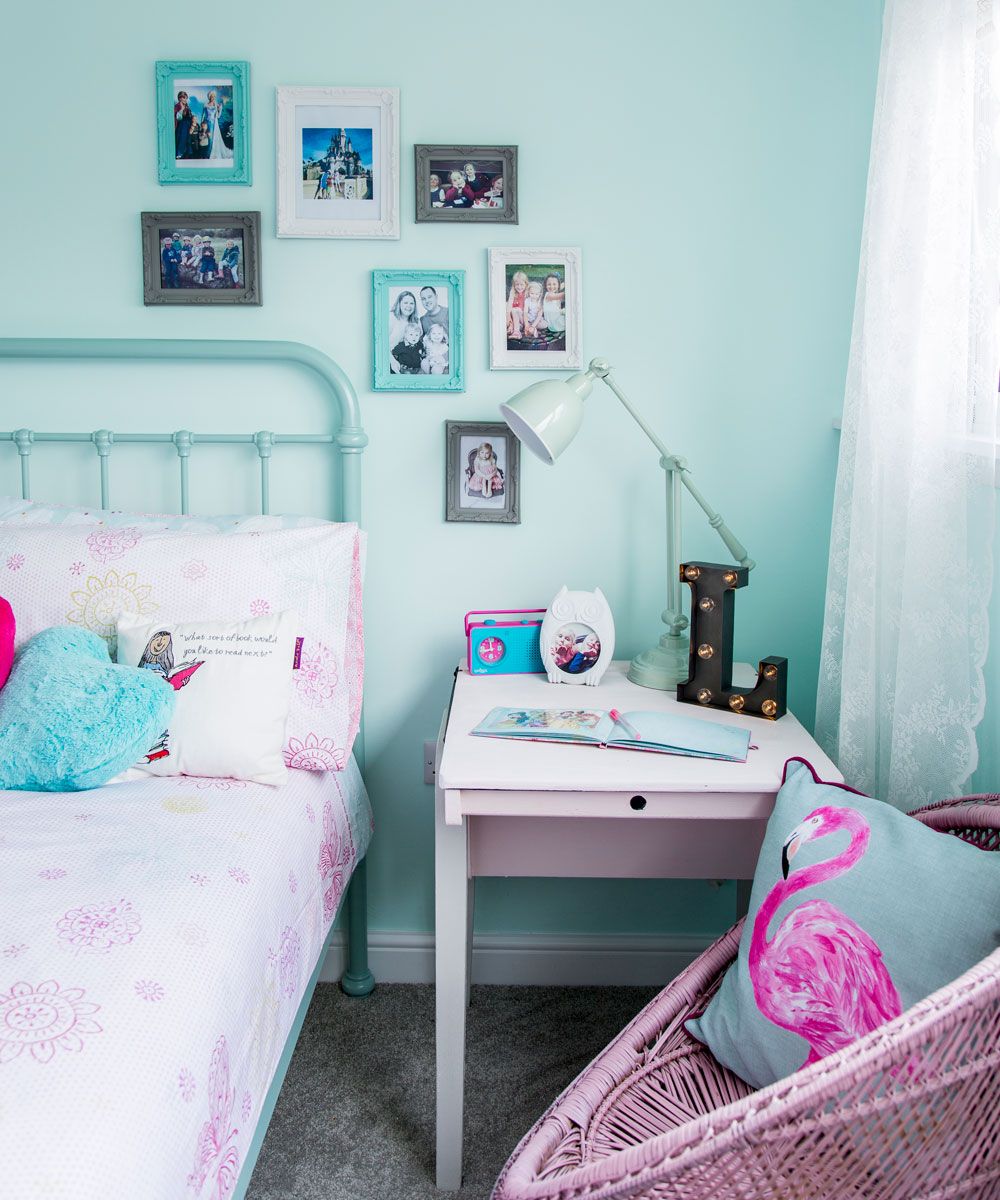
(Image credit: Future PLC/ Lizzie Orme)
A small desk that doubles as a bedside table is a great solution for a small bedroom. Welcome a chair that can be used both by mum for a bedtime story and by a child for homework or colouring-in. The soft contrast between the pink and the blue colour scheme keeps the eye moving around the room so it doesn’t feel stagnant.
24. Streamline furniture choices
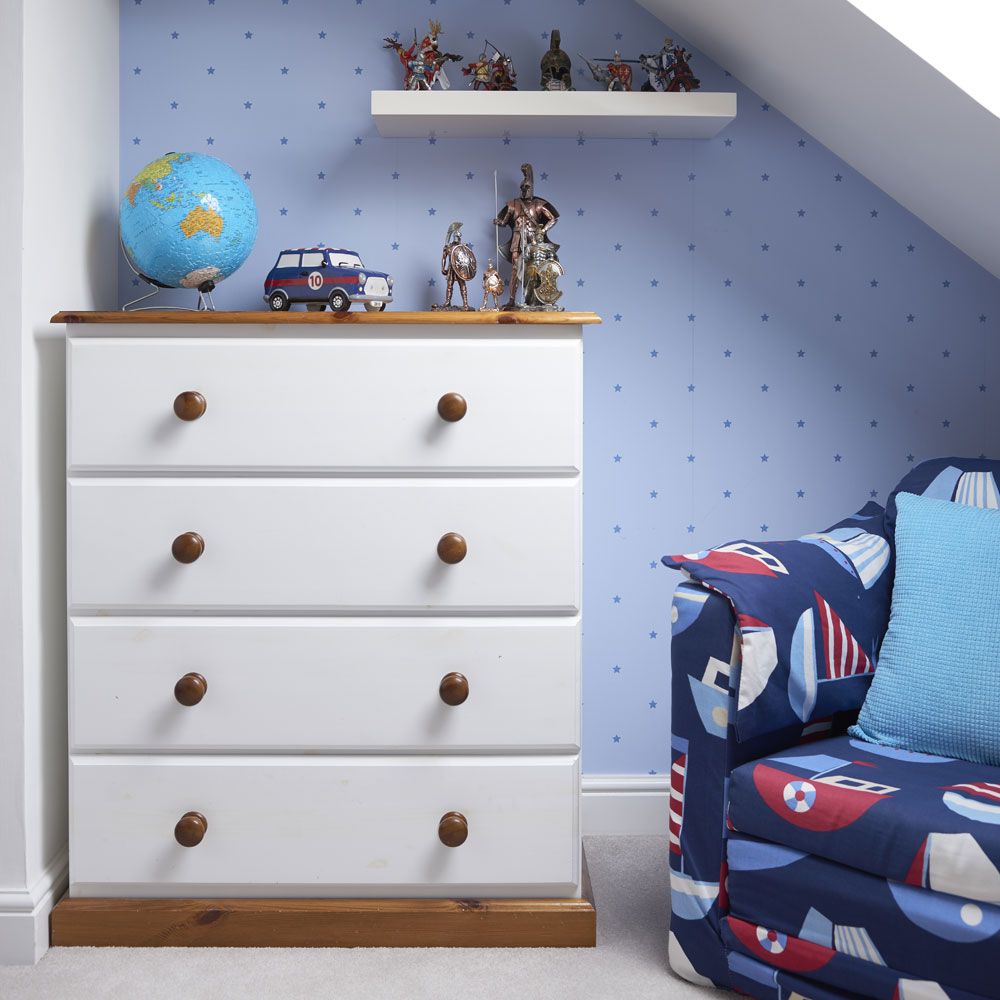
(Image credit: Future PLC/ Olly Gordon)
Cramming too many things into a small room is a sure-fire way to make it feel claustrophobic. Because of this, it’s important to prioritise what your child needs and what they don’t. Children’s clothes don’t require full-length hanging space so a half-wardrobe, half-drawer option can be a real winner in a small room.
25. Make the most of high ceilings
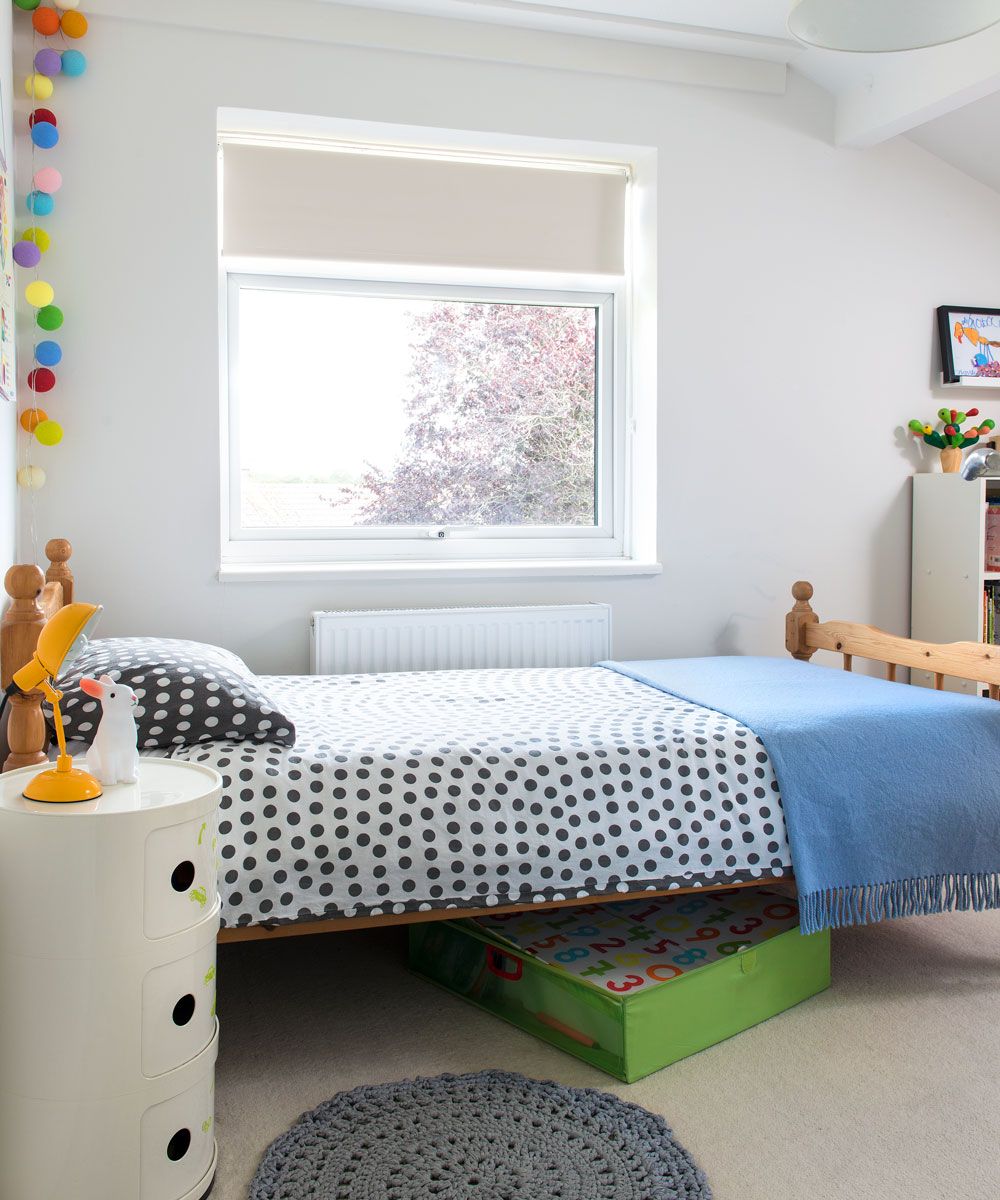
(Image credit: Future PLC/ Colin Poole)
If floor space is small but the ceiling is relatively high, drawing attention to the latter can make the space feel roomier than it essentially is. The best way to do this is with choice, trailing decorations that draw the eye to specific places without making the room unbalanced.
Here, a string of fun, brightly-coloured spherical lights lifts the attention away from any potential playtime clutter on the floor and towards the clean, high walls. Fun alternatives could be butterflies on an invisible wire that seem to fly away or cute hanging charms around a light fixture. Be cautious: such decorations should be carefully selected, or else the room feels too crammed with embellishments.
26. Introduce colour to lift a small space

(Image credit: TBC)
Whichever path you choose, make the bed feel incorporated explicitly into the design, rather than a functional necessity. Paint colour can add interest to a plain wall and play off a simple design. This mountainscape in warm orange is a lovely addition and makes a feature of the open shelf and the bed below, complimenting the pale wooden furniture. A thought-out decorating style keeps a room from feeling too untidy.
How can I make the most of a small children’s bedroom on a budget?
Whether large or small the most affordable way to decorate a space is with paint. Rachel Homer, interiors writer and mum of two suggests. ‘For small children’s bedrooms, go for a two-toned paint effect that is not only on-trend but will create an illusion of space.
‘Keep the top half a light and bright shade to bounce light around the room. Then choose a darker shade for the bottom which will also be practical for hiding wear and tear. When it comes to storage, plastic boxes and tubs are more affordable than wooden versions and available in all types of beautiful and bright colours to match your scheme.’
What’s the best layout for a small children’s room?
When it comes to small kids’ room ideas for design and layout – less is usually more. Keep the decor simple and add colour through accessories and toys. Make sure shelves and furniture are mounted at a child-friendly level and where you can choose ‘mini-version’ furniture to increase the sense of space.
Carl Walsh from Bed Guru (opens in new tab) says to measure your space so you know exactly what you’re working with, and can plan your bedroom so it makes use of every spare inch. Hunt down a piece that matches your measurements as closely as possible.
Place furniture around a floor-play space if possible or keep the area under a raised bed clear for this purpose. Lastly, go for a simple window treatment that allows lots of daylight into the room. A simple blackout blind is a practical option.
How do you fit two kids in a small bedroom?
Fitting two young kids into a small room is a common decorating dilemma for many growing families. Being smart with furniture and storage solutions is key to shared bedroom ideas because both are necessary but both take up valuable space. Choosing bunk beds is one of the best options, with two stacked beds instead of one over the same floor space. Use valuable wall space to hang racks, peg rails and clothes hooks to elevate belongings off the floor.
Will you be using these small kids’ room ideas to give your child’s room a magical makeover?